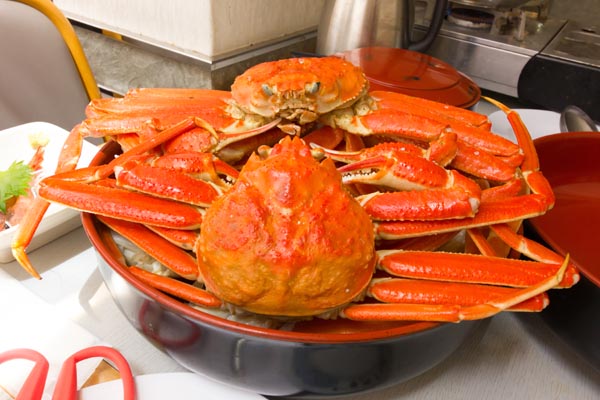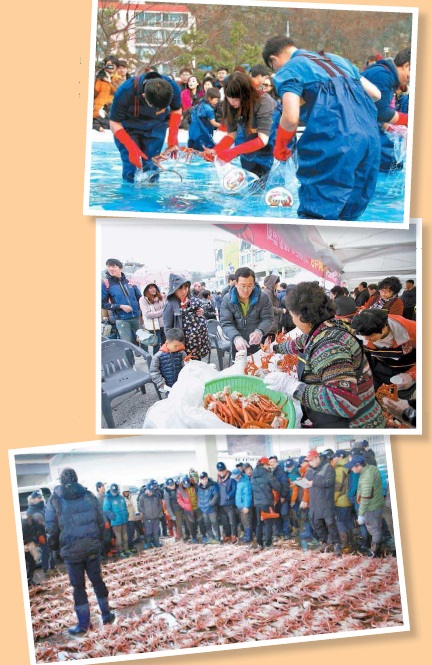Make the most of crab season

ULJIN COUNTY, North Gyeongsang - Traveling five hours from Seoul to Uljin County is less boring if there’s tasty crab waiting at the end.
For seafood connoisseurs, the winter months are the most exciting since marine products are in season. The seaside county, known for its snow crab, even holds an annual crab festival to entice more visitors to come enjoy the local specialty.
At Hupo Harbor in the southern part of Uljin, fishermen bring their catch in to auction off every morning at 7:30 a.m. Merchants lay out the crabs in rows so that local restaurant owners and retailers can check their size and quality.
When the auction starts, buyers from nearby counties and cities wearing dark navy caps with numbers on them start writing down their offers for certain lots of crabs on small wooden blackboards.

Top and middle: At the Uljin Snow Crab Festival, visitors can try catching crabs in the water and try steamed crab. Above: To see how snow crab is bought and sold while in season, check out the auctions at Hupo Harbor. [LIETTO, LEE SUN-MIN]
The wholesale price of snow crab differs depending on the quantity brought in each day, but falls somewhere between 10,000 won ($8.21) and 20,000 won. However, regular visitors cannot participate in these auctions but must go to smaller retailers.
The retail price can go as high as 35,000 won per crab, but sometimes falls below 15,000 won, according to a restaurant owner at the auction. Those crabs missing legs can usually be bought for cheaper.
While red snow crab, known as honggae, is available all year long, what’s called daegae, the original snow crab, is only available during the winter months. Usually the season lasts from November to April, but locals say the ones caught from late January to March taste the best.
There is a slight difference in taste between honggae and daegae, with honggae being milder while daegae is sweeter.
Daegae is usually more expensive even though it is caught in relatively shallower waters from 100 (328 feet) to 400 meters deep, while honggae is caught in deeper water at 2,000 meters below the surface, because the quantity of honggae being caught is so much greater than that of daegae.
Since both honggae and daegae have red shells, the easiest way to differentiate the two types is by looking at the underside. When you flip the crab over, honggae have a redder belly while daegae have a white underside.
There are many crab restaurants near Hupo Harbor and Jukbyun Harbor. Wangdol Susan, one of the most popular seafood restaurants in the area, serves not only steamed crab but also fried rice in crab shells and spicy soup.
Many travelers coming to enjoy crab usually choose to stay by the water where the restaurants are plentiful so that they can eat dinner, sleep, and then eat more crab the next day for breakfast.
If you are worried about the impact of such a crab feast on your wallet, try visiting during the annual Uljin Snow Crab Festival set to happen later this month. The festival not only features a variety of activities like catching crabs in the water, but more importantly, it involves free steamed crab for visitors.
There are certain times when the crab is given out, so make sure to call ahead and confirm the time closer to the festival date.
BY LEE SUN-MIN [summerlee@joongang.co.kr]
The Uljin Snow Crab Festival starts Feb. 27 and runs through March 1 in Uljin County, North Gyeongsang. Admission is free. To get to Uljin, take a bus from Dong Seoul Bus Terminal. The trip takes about five hours.
For more information, go to eng.uljin.go.kr or call (054) 787-1330~1.










with the Korea JoongAng Daily
To write comments, please log in to one of the accounts.
Standards Board Policy (0/250자)